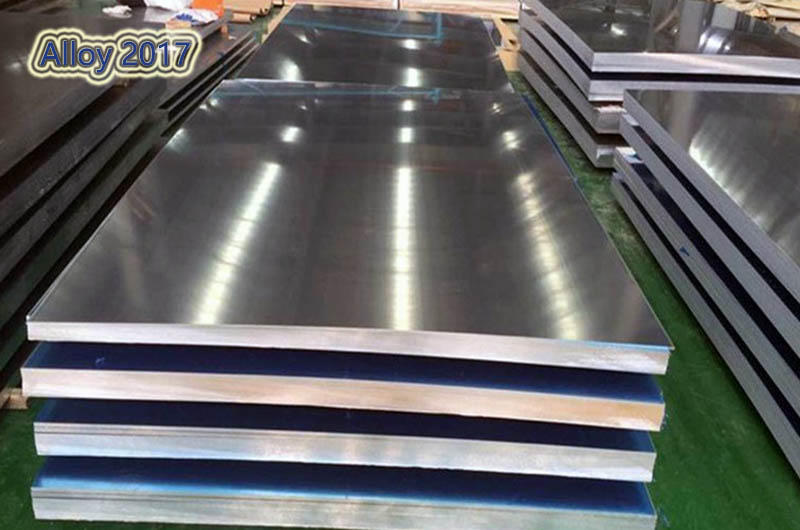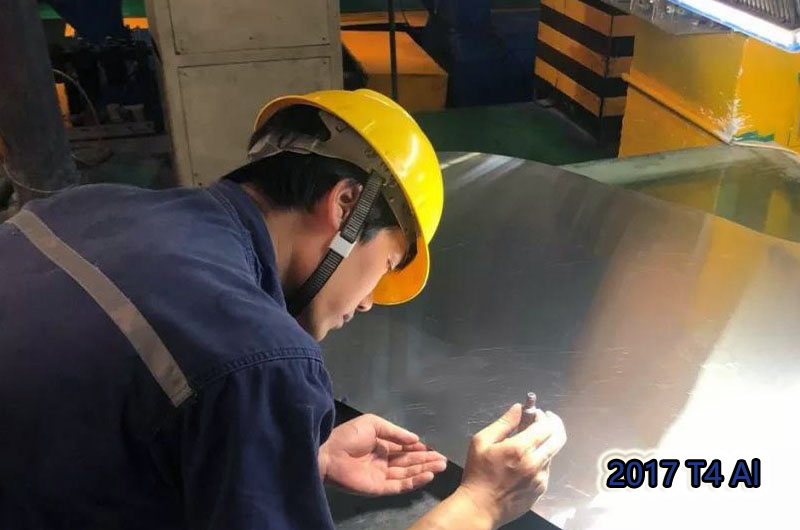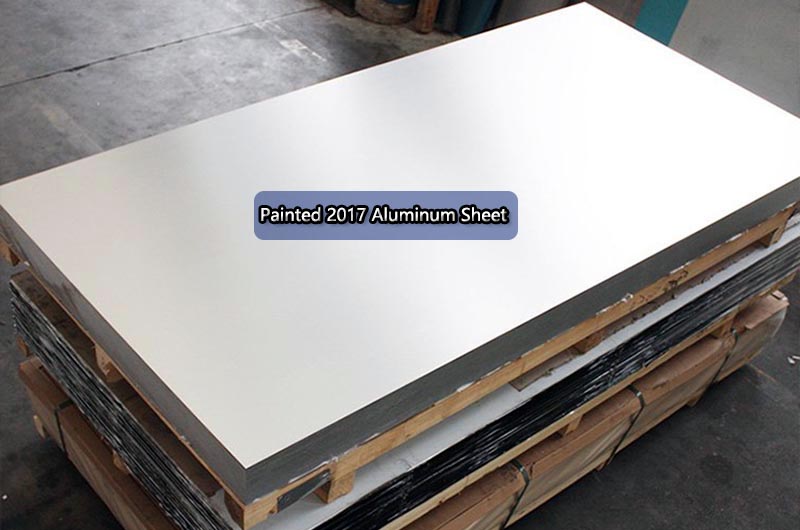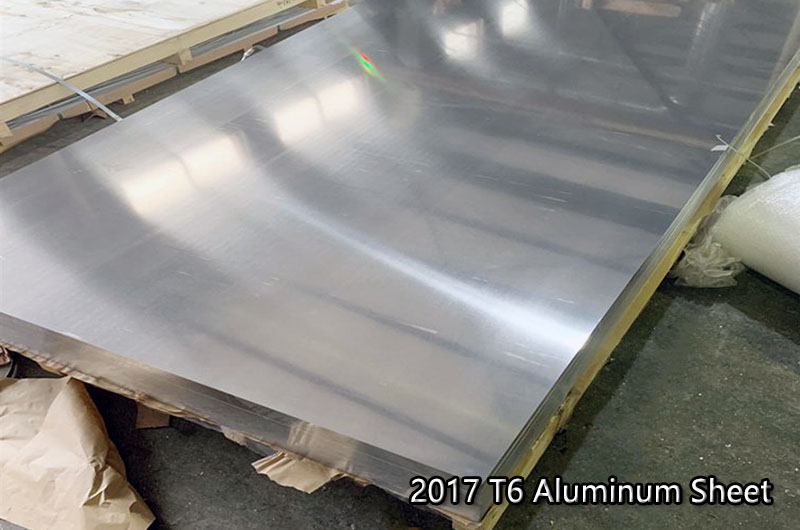2017 Aluminum Plate Sheet
Temper: T4/T6 ASTM B209,AMS 4118,QQ-A-250/4
2017 aluminum plate refers to the aluminum plate made of 2017 alloy. 2017 aluminum alloy is a high-strength material with copper as the main alloying element. It also contains small amounts of magnesium, manganese, and other trace elements.
The characteristics of 2017 aluminum alloy are:
- 1. It has high strength and certain heat resistance and can be used as working parts below 150°C.
- 2. At temperatures above 125°C, the strength of the 2017 aluminum alloy is higher than that of the 7075 aluminum plate.
- 3. The formability is relatively good in the hot state, annealed, and newly quenched states, and the heat treatment strengthening effect is significant, but the heat treatment process requirements are strict.
- 4. The corrosion resistance is poor, but it can be effectively protected by coating with pure aluminum.
- 5. Cracks are prone to occur during welding, but special processes can be used to weld or rivet them.

Alloy 2017 has excellent machinability and is often used in applications requiring high strength and good corrosion resistance. Has good fatigue strength and is easy to weld. In addition, it also has good heat treatment performance, which can be further strengthened by the heat treatment process.
2017 Aluminum Plate Material Properties
| Property | Value |
|---|---|
| Density | 2.78 g/cm³ (0.100 lb/in³) |
| Melting Point | 548-652°C (1018-1206°F) |
| Tensile Strength | 40, 000-63, 000 psi (275-435 MPa) |
| Yield Strength | 35, 000-55, 000 psi (240-380 MPa) |
| Elongation | 12-20% |
| Modulus of Elasticity | 10.4 x 10^6 psi (72 GPa) |
| Hardness | 55-120 Brinell hardness (HB) |
| 95-150 Vickers hardness (HV) | |
| Electrical Conductivity | 33-38% IACS |
| Thermal Conductivity | 140-160 W/m·K |
NOTE: These material properties are approximate and may vary based on specific manufacturing processes, alloy compositions, and heat treatment conditions. We always recommend that you refer to the manufacturer's specification or data sheet for accurate information on the material properties of a particular 2017 aluminum alloy.
Specifications of 2017 Aluminum Plates
Common specifications for the 2017 aluminum sheet may vary depending on the specific requirements of the application. However, some of the
The common sizes of aluminum sheets in 2017 usually range from small to large, and the sizes are as follows:
| Properties | Value |
|---|---|
| Thickness | 0.125" (3.175mm) to 6" (152.4mm) or more |
| Width | 12 inches (304.8 mm) to 72 inches (1828.8 mm) or more |
| Length | 24" (609.6mm) to 144" (3657.6mm) or longer show in table |
Common thicknesses of 2017 aluminum sheet may vary depending on the intended application, but some common options include:
Common Thickness of 2017 Aluminum Plate
| Alloy | Inch Measurement | Millimeter Equivalent |
|---|---|---|
| 2017 Aluminum Plate | 1/4 in | 6.35 mm |
| 2017 Aluminum Plate | 3/8 in | 9.53 mm |
| 2017 Aluminum Plate | 1/2 in | 12.7 mm |
| 2017 Aluminum Plate | 3/4 in | 19.05 mm |
| 2017 Aluminum Plate | 1 in | 25.4 mm |
Regarding the common state of aluminum sheets in 2017, the most common state is T4, which means that the aluminum sheets have been solution heat treated and naturally aged to a stable state. Other tempers such as T6, T651, and T451 are also available, which involve an additional heat treatment process to increase the strength and hardness of the material.

2017 Aluminum Plate Common Standards:
- ASTM B209: Standard Specification for Aluminum and Aluminum Alloy Plates and Plates
- AMS 4118: Aluminum Alloys, Rolled or Cold-Worked Bar, Rod, Wire, and Flash Welding Rings
- QQ-A-250/4: 2017 Federal Specification for Aluminum Alloy Plate
Equivalent to Aluminum 2017
- AA2017 (AA stands for Aluminum Association)
- AlCu4MgSi (European designation)
- EN AW-2017A (European designation)
- UNS A92017 (Unified Numbering System)
- Al2017
- Alloy 2017
It is worth noting that the availability of specific sizes, thicknesses, and hardnesses may vary by supplier or manufacturer. Hence, it is advisable to consult a reliable supplier or refer to technical specifications for accurate information on the availability of the 2017 Aluminum Sheet in your required size and hardness.
Yield Strength of 2017 Aluminum Plate
| Temper | Yield Strength |
|---|---|
| 2017 T4 Aluminum Plate | 35, 000-40, 000 psi |
| 2017 T6 Aluminum Plate | 50, 000-55, 000 psi |
| 2017 T451 Aluminum Plate | 40, 000-45, 000 psi |
| 2017 T651 Aluminum Plate | 45, 000-50, 000 psi |
2017 Aluminum Plate Corrosion
The 2017 aluminum alloy has good corrosion resistance, but it is not as corrosion resistant as some other aluminum alloys that contain higher amounts of alloying elements such as copper or magnesium. The corrosion resistance of 2017 aluminum alloys is affected by several factors, including the environment, exposure conditions, and surface treatment.
The 2017 aluminum alloy exhibits good atmospheric corrosion resistance and is suitable for outdoor applications. However, it is important to note that prolonged exposure to harsh or corrosive environments may cause corrosion, especially if not properly protected.
To enhance the corrosion resistance of 2017 aluminum alloy, various surface treatments can be applied, such as:
- Anodized: Anodizing forms a protective oxide layer on the surface of aluminum, improving its corrosion resistance.
- Chemical Conversion Coatings: Chemical treatments such as chromate conversion coatings or phosphate conversion coatings can provide a protective layer on the surface of the alloy, enhancing its corrosion resistance.
- Paint or Coated Systems: The use of paint or other protective coatings can provide an additional barrier against corrosion.

It is important to select the proper surface preparation or protective coating based on the specific application and desired level of corrosion resistance.
In highly corrosive environments or where maximum corrosion resistance is required, it may be more appropriate to consider alternative aluminum alloys with higher alloying element content, such as 5052 or 6061, which offer excellent corrosion resistance.
The corrosion resistance of 2017 aluminum alloys is affected by specific conditions and other factors such as temperature, humidity, chemical exposure, and mechanical stress. It is recommended to consult a materials expert or refer to the technical specifications provided by the manufacturer for details on the corrosion resistance of 2017 aluminum alloys in a particular application or environment.
2017 Aluminum Plate Composition
| Element | Composition Range (wt.%) |
|---|---|
| Aluminum | Balance |
| Copper (Cu) | 3.5 - 4.5 |
| Magnesium (Mg) | 0.4 - 1.0 |
| Manganese (Mn) | 0.4 - 1.0 |
| Iron (Fe) | 0.7 max |
| Silicon (Si) | 0.2 - 0.8 |
| Zinc (Zn) | 0.25 max |
| Others | < 0.15 each, < 0.05 total |
Note: These are typical ingredient ranges and may vary depending on the specific manufacturing process and desired properties. It is always advisable to refer to the specification or data sheet provided by the manufacturer for the precise composition of a particular batch of 2017 aluminum alloy.
Typical 2017 Aluminum Plate Sheet
2017 T4 Aluminum Plate
- T4: Solution heat treated and naturally aged to a steady state. This state provides good formability, machinability, and moderate strength.
- The T4 state refers to the aluminum plate that has undergone solution heat treatment and natural aging to a stable state. It has good formability, machinability, and moderate strength.
- T4 aluminum sheet is generally used in applications that require moderate strength, excellent machinability, and good corrosion resistance. It is suitable for components in the aerospace, automotive, marine, and general engineering industries.
- The exact properties, dimensions, and available sizes of the 2017 T4 aluminum sheet may vary by manufacturer or supplier.
2017 T6 Aluminum Plate
- T6: Solution heat treatment and artificial aging. This temper has higher strength and hardness compared to T4. It has excellent machinability and moderate formability.
- The T6 state refers to the aluminum plate that has undergone solution heat treatment and artificial aging treatment. Compared with T4, it has higher strength and hardness.
- T6 aluminum sheet is generally used in applications that require high strength, excellent machinability, and good corrosion resistance. It is suitable for structural components, aircraft parts, and high stress applications.
- The exact properties, dimensions, and available sizes of the 2017 T6 aluminum sheet may vary by manufacturer or supplier.

2017 T451 Aluminum Plate
- T451: Solution heat treatment, stress relief by controlled stretching, and natural aging. This temper provides improved stress corrosion resistance and moderate strength.
- The T451 state refers to the aluminum plate that has undergone solution heat treatment, controlled stretching to relieve stress and natural aging. It has higher stress corrosion resistance and moderate strength.
- T451 aluminum sheet is often used in applications requiring good stress corrosion cracking resistance, moderate strength, and good formability. It is suitable for aerospace, marine, and structural components.
- The exact properties, dimensions, and available sizes of the 2017 T451 Aluminum Sheet may vary by manufacturer or supplier.
2017 T651 Aluminum Plate
- T651: Solution heat treatment, tensile stress relief, artificial aging. It had the highest strength and hardness in the common state of aluminum sheets in 2017. This state is suitable for applications requiring high strength and excellent machinability.
- The T651 state refers to the aluminum plate that has undergone solution heat treatment, tensile stress relief, and artificial aging treatment. It had the highest strength and hardness in the common state of aluminum sheets in 2017.
- T651 Aluminum Sheet is commonly used in applications that require high strength, excellent machinability, and good corrosion resistance. It is suitable for aerospace, automotive, and highly stressed structural components.
- The exact properties, dimensions, and available sizes of the 2017 T651 Aluminum Sheet may vary by manufacturer or supplier.
Typical Applications 2017 Aluminum Plate
2017 Aluminum sheets are commonly used in aerospace, automotive, and transportation industries, and the manufacture of various machinery, structural parts, and precision parts.
2017 Aluminum sheet is commonly used in a variety of industries and applications requiring a combination of strength, workability, and corrosion resistance. Some typical applications of aluminum sheets in 2017 include:
- Aerospace Components: Due to its good strength-to-weight ratio and excellent machinability, the 2017 aluminum sheet is used in the aerospace industry to manufacture structural components, aircraft accessories, wing ribs, and other critical components.
- Auto parts: 2017 Aluminum sheets are used in the automotive industry for the production of engine parts, gearbox housings, suspension parts, and wheels. Its high strength and machinability make it suitable for these applications.
- Marine Equipment: The corrosion resistance of the 2017 aluminum sheet makes it suitable for marine applications. It is used in the manufacture of marine equipment, marine fittings, and hull components that require both strength and saltwater corrosion resistance.
- General Engineering: 2017 Aluminum Sheet is used in a variety of general engineering applications requiring moderate strength and good machinability. It can be found in the production of machine parts, brackets, frames, and other structural components.
- Electrical components: The excellent electrical conductivity of aluminum makes 2017 aluminum sheets suitable for applications in the electrical industry. It can be used to make electrical enclosures, connectors, busbars, and heat sinks.
- Defense and Military: 2017 Aluminum sheet is used in defense and military applications for the production of components such as military vehicle parts, aircraft accessories, and weapon systems. Its strength and corrosion resistance make it suitable for these demanding applications.
- Sports Goods: The high strength and machinability of the 2017 aluminum sheet make it popular in the manufacture of sporting goods. It can be used in the production of bicycle frames, baseball bats, golf club heads, and other sports equipment.

NOTE: Specific applications may vary depending on the desired properties, size, and thickness of the 2017 aluminum sheet. Consultation with the manufacturer or supplier is recommended to ensure that the selected alloy and plate meet the specific requirements of the intended application.
2017 Aluminum Plates Frequently Asked Questions (FAQs)
How do I Machine 2017 Aluminum Plates?
2017 aluminum is known for its excellent machinability. It can be easily turned, milled, drilled, and tapped. Using high-speed steel or carbide tools is recommended for best results.
Can 2017 Aluminum be Heat-treated?
Yes, 2017 aluminum can be heat-treated to further enhance its mechanical properties. The T4, T6, and T451 tempering processes are commonly used to achieve various levels of strength and hardness.
What is the difference between 2017-T4 and 2017-T6 Aluminum?
The "T4" and "T6" refer to different tempering processes. 2017-T4 aluminum is naturally aged to a certain level of hardness, while 2017-T6 aluminum is solution heat-treated and artificially aged for higher strength and hardness.
Can 2017 Aluminum be Anodized?
Yes, 2017 aluminum can be anodized to improve its corrosion resistance and provide a decorative finish. Anodizing also allows for various color options.
Is 2017 Aluminum suitable for Marine Applications?
While 2017 aluminum offers corrosion resistance, it is not the best choice for marine environments due to its susceptibility to stress corrosion cracking in certain conditions. Marine-grade aluminum alloys like 5052 or 5083 are typically preferred.
2017 Aluminum Plate vs 6061
Composition
- 2017 aluminum alloy: the main components are aluminum, copper (about 3.5-4.5%) and magnesium (about 0.4-1.0%). It may also contain small amounts of manganese, iron, silicon, and zinc.
- 6061 aluminum alloy: the main components are aluminum, magnesium (about 0.8-1.2%), and silicon (about 0.4-0.8%). It may also contain small amounts of chromium, copper, iron, manganese, and zinc.
Strength and Hardness
- 2017 Aluminum Alloy: Provides medium strength and hardness, especially in the T6 temper.
- 6061 aluminum alloy: Compared to the 2017 alloy, it has higher strength and hardness, especially in T6 temper.
Machinability
- 2017 Aluminum alloy: Has excellent machinability and is suitable for machining operations.
- 6061 aluminum alloy: also has good machinability, but may be slightly lower compared to 2017 alloy due to higher silicon content.
Corrosion Resistance
- 2017 Aluminum alloy: Has good corrosion resistance, especially in atmospheric environments.
- 6061 aluminum alloy: Has good corrosion resistance, including resistance to stress corrosion cracking. It can be further enhanced with proper surface treatment.
Weldability
- 2017 aluminum alloy: generally has good weldability.
- 6061 aluminum alloy: has good weldability, although certain factors such as material thickness and filler metal selection can affect the welding process.
Typical Applications
- 2017 Aluminum alloy: Commonly used in aerospace components, structural parts, and high-strength applications requiring excellent machinability.
- 6061 aluminum alloy: Due to its excellent strength-to-weight ratio, weldability, and corrosion resistance, it is widely used in various industries, including aerospace, automotive, marine, and structural applications.
It is worth noting that the specific characteristics and properties of these alloys may vary depending on the temper and heat treatment employed. Additionally, other factors such as application requirements, cost considerations, and availability may also influence the choice between 2017 and 6061 aluminum alloys.
2024 vs. 2017 Aluminum Plate
Composition
- 2024 aluminum alloy: the main components are aluminum, copper (about 3.8-4.9%), and a small amount of magnesium (about 1.2-1.8%), manganese and other trace elements.
- 2017 aluminum alloy: the main components are aluminum, copper (about 3.5-4.5%) and magnesium (about 0.4-1.0%). It may also contain small amounts of manganese, iron, silicon, and zinc.
Strength and Hardness
- 2024 Aluminum Alloy: High strength and excellent fatigue resistance for aerospace applications.
- 2017 Aluminum Alloy: Provides medium strength and hardness, especially in the T6 temper.
Machinability
- 2024 aluminum alloy: has good machinability and is suitable for machining operations.
- 2017 Aluminum alloy: Has excellent machinability and is suitable for machining operations.
Corrosion Resistance
- 2024 Aluminum Alloy: Good corrosion resistance in some environments, but less corrosion resistant than other aluminum alloys such as 2017 or 6061.
- 2017 Aluminum alloy: Has good corrosion resistance, especially in atmospheric environments.
Weldability
- 2024 Aluminum Alloy: Fairly weldable, but challenging due to high copper content which can lead to weld cracking. Proper technique and filler metal selection are important.
- 2017 aluminum alloy: generally has good weldability.
Typical Applications
- 2024 aluminum alloy: Widely used in the aerospace field, such as aircraft structures, wing skins, fuselage components, and other occasions that require high strength and fatigue resistance.
- 2017 Aluminum alloy: Commonly used in aerospace components, structural parts, and high-strength applications requiring excellent machinability.
When selecting aluminum alloys for 2024 to 2017, it is important to consider specific requirements such as strength, corrosion resistance, machinability, and application limitations. The final choice depends on the desired properties and the suitability of the alloy for the intended application.
People also searched for Aluminum Plate
-
2219 Aluminum Plate Sheet
2219 aluminum alloy is a high-strength alloy, high temperature resistant and good cutting processing and good mechanical properties. 2219 aluminum plates are in line with AMS QQ-A-250/30. Common TEMPER includes T31, T81, O, etc.
-
2024 t851 Aluminum Plate Sheet
2024 T851 aluminum is commonly used in aerospace and military applications, such as the construction of aircraft structural components, due to its excellent strength-to-weight ratio and fatigue resistance.
-
2024 Aluminum Plate Sheet
2024 aluminum is a prominent hard aluminum alloy in the aluminum-copper-magnesium series. 2024 aluminum plates are famous for their high strength and excellent fatigue resistance, as well as their ability to be easily processed and welded.
-
2024 T3 Aluminum Plate Sheet
2024 T351 aviation aluminum plate is a high-strength aviation aluminum alloy material. T351 has large surface and internal residual stress and good explosion impact resistance. 2024 t351 is one of the aviation aluminum alloys. It is widely used in skins, bulkheads and structural parts that need to withstand high cyclic loads on various aircraft.
-
2024 T4 Aluminum Plate Sheet
2024 T4 aluminum has a high strength-to-weight ratio and good fatigue resistance, making it a popular choice for aerospace and structural applications. It also has good machinability and weldability, although it is not as corrosion resistant as some other aluminum alloys.
-
7075 Aluminum Plate Sheet
7075 is one of the strongest aluminum alloys available, with an excellent strength to weight ratio. 707 Aluminum Plate is ideal for highly stressed aircraft components.
-
7075 T6 Aluminum Plate Sheet
The 7075 T6 Aluminum Plate Sheet produced by us has a flat surface, smooth surface, no burrs, stable performance and competitive price.
-
7075 T651 Aluminum Plate Sheet
We have rich experience in producing 7075 T651 Aluminum Plate Sheet. The product has a flat surface and uniform thickness. The quality inspection meets the standards and the price is competitive.
-
7075 T7351 Aluminum Plate Sheet
The quality inspection of the 7075 T7351 Aluminum Plate Sheet conforms to the standard, the performance is stable, and it has relevant certifications for aluminum plates, such as ISO 9001, etc.
-
7075 T7451 Aluminum Plate Sheet
We have 7075 T7451 Aluminum Plate Sheet related certifications, such as ISO 9001, etc. There is no problem with the quality of the aluminum plate, and the specifications are complete.

